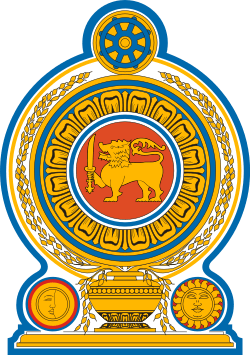Ranasinghe Premadasa
Sri Lankabhimanya Ranasinghe Premadasa (Sinhala: රණසිංහ ප්රේමදාස,Tamil: ரணசிங்க பிரேமதாசா; 23 June 1924 – 1 May 1993)[1] was the third (Second Executive) President of Sri Lanka from 2 January 1989 to 1 May 1993. Before that, he served as the Prime Minister in the government headed by J. R. Jayewardene from 6 February 1978 to 1 January 1989. He was awarded Sri Lanka's highest award to a civilian Sri Lankabhimanya in 1986 by President Junius Richard Jayewardene, the first to receive in Sri Lankan history. He was assassinated in Colombo in a suicide bombing by the LTTE.[2][3]
Ranasinghe Premadasa | |
|---|---|
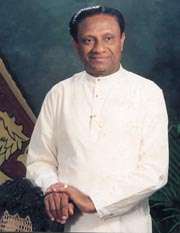 | |
| 3rd President of Sri Lanka | |
| In office 2 January 1989 – 1 May 1993 | |
| Prime Minister | Dingiri Banda Wijetunga |
| Preceded by | Junius Richard Jayewardene |
| Succeeded by | Dingiri Banda Wijetunga |
| 8th Prime Minister of Sri Lanka | |
| In office 6 February 1978 – 2 January 1989 | |
| President | Junius Richard Jayewardene |
| Preceded by | Junius Richard Jayewardene |
| Succeeded by | Dingiri Banda Wijetunga |
| Member of Parliament for Colombo Central | |
| In office 22 March 1965 – 2 January 1989 | |
| Preceded by | Razik Fareed |
| Succeeded by | constituency abolished |
| In office 19 March 1960 – 20 July 1960 | |
| Preceded by | M.S. Themis |
| Succeeded by | Razik Fareed |
| Personal details | |
| Born | 23 June 1924 Colombo, British Ceylon (now in Sri Lanka) |
| Died | 1 May 1993 (aged 68) Colombo, Sri Lanka |
| Nationality | Sri Lankan |
| Political party | United National Party |
| Spouse(s) | Hema Premadasa (née Wickrematunge) |
| Children | Sajith, Dulanjali |
| Alma mater | St Joseph's College, Colombo |
Early life
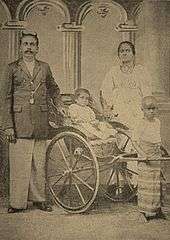
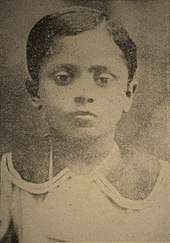
R. Premadasa was born on 23 June 1924 at Dias Place, Colombo 11, to the family of Richard Ranasinghe (Ranasinghe Mudalali) of Kosgoda and Jayasinghe Arachchige Ensina Hamine of Batuwita, Horana. R. Premadasa was the oldest of five children, three sisters, and one brother. He received his primary education at Harvard Girls’ School, Dam Street, Colombo, post primary education at St. Lorenz's College, Skinner's Road South (Now Sri Sangaraja Mawatha, Maradana) and his secondary education at St. Joseph's College, Colombo. While attending school, he attended the Hewavitharana Daham Pasala. He completed his education at St. Joseph's College, during the Le Goc era. He satisfied all the requirements for registering at the University of London for higher studies. However, he gave up this opportunity to engage in higher studies and chose path of social service for the welfare of the poor and down- trodden.
He, the architect of the Sri Sucharitha Movement, a volunteers organisation with the objectives of uplifting the economic, social and spiritual development of the low income people living in shanty areas of the capital. He was the full-time organizer of the community development project of the area in 1939. These youth who enrolled in his development movement refrained from taking liquor and avoided smoking and gambling. Premadasa too was a teetotaler.
Political career
Allying with late A. E. Goonesinghe, the founder leader of the Ceylon Labour Movement, he commenced his political life. He had several ups and downs in that era. He had been the Deputy Mayor of the Colombo Municipal Council while functioning as a member of San Sebastian's Ward. Joining hands with late Dudley Senanayake, he joined the UNP and contested Dr. N. M. Perera unsuccessfully in the Ruwanwella constituency at the general election held in 1956. After his first failure to enter Parliament, he, in the process of reorganising the UNP, visited every nook and corner of the country, while also being the secretary of the Religious Affairs Committee of the Buddhist Council appointed by the government to organize the 2500th Buddha Jayanthi celebrations.
The following year he joined the protest march to Kandy on October 3, which had been organized by the late J.R. Jayewardene (later President). This march was disrupted at Imbulgoda by some thugs led by S. D. Bandaranayake. He was elected the third Member of Parliament for Colombo Central in the Dudley Senanayake government at the general election held in March 1960, but failed in the July general election. Later he was elected Member for the Cinnamon Gardens Ward in the Colombo Municipal Council.
Premadasa initially supported the Labour Party, then headed by A. Ekanayake Gunasinha. He was elected Deputy Mayor of Colombo in 1955.[3] Having realized that the Labour Party in the 1950s didn't have a very promising future, in 1956 Premadasa joined the moderate United National Party,[3] and contested 1956 parliamentary election for Ruwanwella Electorate was defeated.[4] He became the first non-Govigama politician to reach to the highest levels in democratic, post-independence Sri Lanka.
Minister
During his tenure as Minister of Broadcasting in Dudley Senanayake's cabinet, Premadasa turned Radio Ceylon, the oldest radio station in South Asia, into a public corporation - the Ceylon Broadcasting Corporation on 5 January 1967.
Part of his political program was shelter for the poor, after the United Nations declared a Year of Shelter. Other policies included Jana Saviya, the instrument he used to help the poor, a foster parents scheme, the Gam Udawa project with which he tried to stir up the stupor in the villages, the mobile secretariat whereby he took the central government bureaucracy to the peasants, the Tower Hall Foundation for drama and music, and the pension schemes he initiated for the elder artistes. On the economic front, the garment industry project that he initiated became a forerunner in earning foreign exchange and provision of employment in the villages.
He was elected second Member of Parliament at the general election held in 1965 for the same seat and was appointed Chief Government Whip besides being appointed Parliamentary Secretary of Local Government. Later he was raised to the position of Minister of Local Government.
Opposition
In the following general election held in 1970, he was elected first MP for Colombo Central and sat in the Opposition with late J.R. Jayewardene, the Leader of the Opposition. Premadasa was once again appointed Chief Opposition Whip. Further, he was elected chairman of the General Assembly of the Commonwealth Inter- Parliamentary Association held in Australia. In the meantime, he held membership of the Constituent Assembly which drafted the constitution of 1972.
Prime Minister
Premadasa was elected first MP for Colombo Central in 1977 and became the Leader of the House and the Minister of Local Government. In addition he became the Deputy Leader of the UNP. When J.R. Jayewardene became the first Executive President of the country, Minister Premadasa became the Prime Minister on February 23, 1978.[5]
Presidency
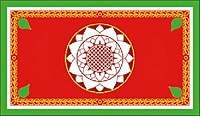
He was elected second Executive President of the country when late J. R. Jayewardene stepped down, and led the UNP to victory at the general election held in 1989. The country faced both a civil war in the north and a communist insurgency in the south at the time, both key issues Premadasa concentrated on, with particularly ruthless actions against the insurgents.[6] The security forces brutally put down the revolt and killed many of its leaders.
Premadasa also concentrated on a grassroots-level economic development drive, focusing on the provision of housing, poverty alleviation and the upliftment of the poor. He encouraged the building of model villages with clean water, transport infrastructure, schools and health centers. He encouraged the establishment of small-scale industries (mostly garment-related) in poor areas by giving factory owners low-interest loans and a share in textile quotas for the United States and Europe.[3] The Gam Udāwa programme is one of his best-known achievements in this area, along with the Janasaviya programme that is today part of the Samurdhi scheme. His proposal to declare 1987 as the International Year of Shelter for the Homeless was unanimously accepted at the 37th session of the United Nations General Assembly.
_with_Hon.Ranasinghe_Premadasa_%26_Mr.Neranjan_Wijeyeratne.jpg)
His handling of the country's civil war was less successful. In the north, the Liberation Tigers of Tamil Eelam were facing off against the Indian Peace-Keeping Force- the Indian presence on the island was unpopular, and Premadasa requested India to pull out its troops. In order to force the IPKF to leave the island, he authorized a clandestine operation to supply arms to LTTE, a collusion that came to light in the report published by the Sri Lankan Presidential Commission to inquire into the 1992 assassination of Lieutenant General Denzil Kobbekaduwa.[7] While the IPKF was recalled by New Delhi in 1990, the government's war with the LTTE resumed, beginning Eelam War II, which ended in a stalemate five years later. The 1990 massacre of Sri Lankan Police officers, which occurred after the policemen were asked to surrender to the LTTE in Batticaloa at Premadasa's request, was later established to have been performed with the same weapons he had supplied them.[8][9]
In September 1991, Premadasa faced an impeachment in parliament led by his two formidable rivals in the UNP, Lalith Athulathmudali and Gamini Dissanayake. He defeated it by adjourning Parliament and the Speaker Mohamed dismissed the impeachment stating a lack of signatures after several of the parliamentarians who supported it withdrew their support after facing threats.[10] He then expelled Athulathmudali and Dissanayake from the party, who then joined to form the Democratic United National Front (DUNF).[11][12]
In 1992, he changed the country's name in English from Sri to Shri Lanka on the advice of soothsayers, who predicted it would improve the country's fortunes.[13] The spelling was restored after his assassination in 1993.[13]
Assassination
Ranasinghe Premadasa was killed along with 17 others on May 1, Saturday, 1993, around 12.45 p.m. during UNP's May day rally in Colombo, by an LTTE suicide bomber. The explosion took place at Armour Street-Grandpass Junction in Hulftsdorp, Colombo while President Premadasa was unofficially supervising the procession as it was heading towards the Galle Face Green from Sugathadasa Stadium. The suicide bomber was later identified as Kulaveerasingam Veerakumar alias 'Babu', a close friend of the President's valet E. M. P. Mohideen. He rode a bicycle towards the President, left it near the President's Range Rover and walked towards the President when security personnel attempted to stop him. Despite this, Mohideen allowed him to get close to the President, when Veerakumar detonated the explosive device. The site of the explosion was cleaned within hours before a proper investigation was conducted. The May Day parade continued even after the explosion for some time.[14]
Another 38 people were injured in the bombing including seven who were seriously wounded. An island-wide curfew was imposed hours after the assassination. Prime minister Dingiri Banda Wijetunga sworn in as the new acting-president in the afternoon. The government did not announce the death of President Premadasa until 6 p.m. local time when state television Rupavahini broadcast a tape of BBC's report of the incident. A period of national mourning was announced until the funeral. Police claimed that they recovered the severed head of a young man suspected to be the bomber, which found to have a cyanide suicide capsule, bearing LTTE tradecraft in his mouth.[15]
Legacy
The climax of the 1993 Indian action thriller film Gentleman was rewritten by director S. Shankar based on the assassination of Ranasinghe Premadasa after a request by film producer Kunjumon.[16] The film was in post production stage when Ranasinghe Premadasa was assassinated and the film was released on 30 July 1993.[17]
Family
In 1960, he married Hema Wickramatunge, the daughter of Mr. and Mrs. Wickramatunge Arachchige Charles Appuhamy of Bandarawela, on June 23, 1964. The son, Sajith, and daughter, Dulanjali, were born to this couple.[5]
References
- "Ranasinghe Premadasa DOB". PRIU GOV LK. Archived from the original on 24 September 2015. Retrieved 14 May 2015.
- Liberation Tigers of Tamil Eelam Backgrounder Archived 26 May 2010 at the Wayback Machine Council on Foreign Relations - 21 July 2008
- Gargan, Edward (2 May 1993). "Suicide Bomber Kills President of Sri Lanka". New York Times.
- 1956 Parliamentary Elections Results. Official Website, Department of Elections, Sri Lanka.
- "The Island". www.island.lk.
- Wijayadasa, K.H.J. (28 April 2012). "Ranasinghe Premadasa: The Rise and Fall of President". island.lk. The Island. Retrieved 27 May 2018.
- "Premadasa armed LTTE: Panel". Expressindia.com. 18 April 1998. Retrieved 17 August 2012.
- "Live News Today, Latest India News, Breaking News, Today Headlines, Election 2019 News". The Indian Express.
- "21 years for the murder of 774 policemen".
- "Unsuccessful Impeachments and legal arguments". archives.dailynews.lk.
- "Sri Lanka: The Untold Story, Chapter 58: Premadasa indicted". Asia Times Online. 2002. Retrieved 9 June 2011.
- "Sri Lanka: Information on whether the police are still seeking the assassins of Lalith Athulathmudali". United Nations High Commissioner for Refugees. 1998. Archived from the original on 18 October 2012. Retrieved 9 June 2011.
- Lankapura, Daya (28 September 2008). "Late President Wijetunge defied popular political belief". nation.lk. The Nation. Retrieved 27 May 2018.
- https://www.colombotelegraph.com/index.php/the-premadasa-assassination/. Retrieved 27 October 2019. Missing or empty
|title=(help) - West, Nigel (15 August 2017). Encyclopedia of Political Assassinations. Rowman & Littlefield. p. 187. ISBN 978-1-538-10239-8.
- ChennaiMay 12, India Today Web Desk; May 12, 2020UPDATED:; Ist, 2020 18:16. "Tuesday Trivia: Assassination of Sri Lanka President inspired the climax of Shankar's Gentleman". India Today. Retrieved 15 June 2020.CS1 maint: extra punctuation (link) CS1 maint: numeric names: authors list (link)
- Ramanujam, Srinivasa; Menon, Vishal (21 July 2018). "KT Kunjumon and 25 years of 'Gentleman'". The Hindu. ISSN 0971-751X. Retrieved 15 June 2020.
External links
- Website of the Parliament of Sri Lanka
- Official Website of United National Party (UNP)
- Remembering Premadasa
- Methek Kathawa Divaina
| Government offices | ||
|---|---|---|
| Preceded by Junius Richard Jayawardene |
President of Sri Lanka 1989–1993 |
Succeeded by Dingiri Banda Wijetunga |
| Preceded by Junius Richard Jayawardene |
Prime Minister of Sri Lanka 1978–1989 |
Succeeded by Dingiri Banda Wijetunga |
| Diplomatic posts | ||
| Preceded by Maumoon Abdul Gayoom |
Chairperson of SAARC 1991 |
Succeeded by Khaleda Zia |
